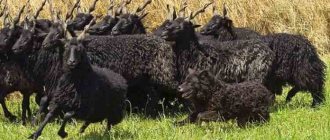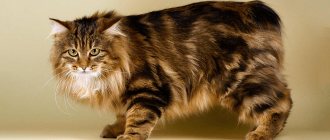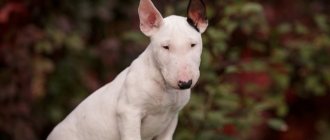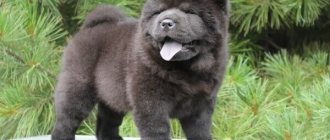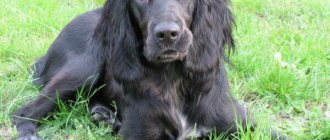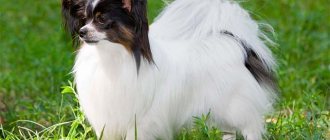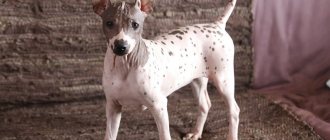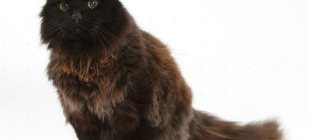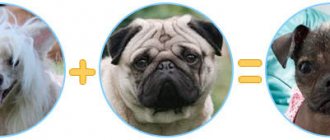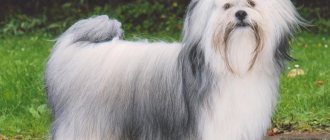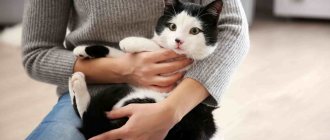The Bull Terrier dog belongs to breeds that are considered aggressive.
But this is an undeserved opinion about the dog, since it is neither a security guard, nor even a bodyguard, since it completely lacks aggression towards people.
What does an adult bull terrier look like in the photo?
The Bull Terrier is a fairly powerful, muscular and very strong medium-sized dog . Its distinctive features are a wedge-shaped head and a triangular muzzle, thanks to which the breed cannot be confused with any other.
The dog's eyes are small, slanted and dark, and they have an unusual triangular shape, characteristic only of representatives of this breed.
The pet's ears are small, thin, and located quite close to each other..
The tail is short, horizontal and conical in shape. In addition, the pet has a powerful neck, dense bones and a wide chest.
The Bull Terrier's coat is short and quite hard.
Color may be:
- White.
- Black.
- Two-color.
- Tricolor.
- Tiger.
- Red.
- Tiger-white.
If the pet has a pure white color, then the nose must be black; with any other color, spots are allowed.
The height of an adult dog is from 30 to 45 cm at the withers, weight - 18-35 kg, life expectancy - 10-12 years, but with good care the dog can live longer.
There are also smaller individuals - miniature bull terriers.
It was customary for the first bull terriers to have their ears cropped, but after the adoption of a law prohibiting cropping, breeders corrected this deficiency and dogs with elegant erect ears appeared..
Origin story
The homeland of the bull terrier is Great Britain. In the 19th century, James Hinks developed the breed. In total, several crossing options were used. The goal of the selection was to breed a dog that would correct all the shortcomings of the breeds. The ideal result was achieved only in 1862. Then three varieties were involved in crossing: English bulldog, terrier and Dalmatian.
The resulting puppies have been depicted in drawings since the beginning of the 19th century. However, the bull terrier received official introduction to the public only in 1860. Then it was a strong white dog. Colored varieties of the breed began to be bred a little later - in the 20th century. For the British, the bull terrier is symbolized with excellent performance, fight and rage. After all, his ancestors (bulldogs and terriers) participated in dog fights, and for this only breeds were selected that had:
- courage;
- desire to win;
- endurance;
- low pain threshold;
- fearlessness.
The modern bull terrier also has all the listed parameters of a fighting dog. From the day he was born, he was endowed with the courage of a bulldog and the agility of a terrier. Although the dog is of medium size, it has plenty of courage and strength. But the main distinguishing feature of the dog is complete submission to its owner.
Breed standard
According to the official breed standard , the Bull Terrier must have the following parameters :
- Strong, muscular and proportional body.
- The head is ovoid, strong, but not rough.
- The muzzle should be wedge-shaped, with the nose line downward.
- The eyes are narrow, slanting, triangular in shape.
- The neck is powerful, strong, muscular.
- The body must be round, with a pronounced convexity of the ribs, while the sternum is located lower than the stomach.
- The paws are round in shape with curled toes.
- In males, both testes should be well developed and descended into the scrotum.
Briefly about character and temperament
The Bull Terrier can be called an active, agile and very sociable dog. He is able to withstand significant loads, is self-sufficient and independent.
With proper upbringing, this is a wonderful companion, guard and everyone's friend..
However, if not properly trained, a dog can be aggressive, unpredictable and even socially dangerous. After all, the breed was bred as a fighting breed and all the qualities of a fighter were preserved in it.
This means that a lot of attention should be paid to education and training.
As for working qualities, with proper upbringing, the dog can be a good guard and watchman, and will also get along with other animals: dogs, cats and even other bull terriers.
What you need to know about the bull terrier
Has a tendency towards obesity. This breed is not suitable for protection. A properly raised animal will be a friendly and devoted friend. This dog does not like to live with other animals and will not tolerate competition.
The animal is quite active, so it needs daily physical activity. The dog does not tolerate loneliness well, and does not tolerate the absence of its owners at home.
The Bull Terrier is suitable for experienced dog breeders who will not give up the leadership position to a four-legged dog. Will be happy to play with your children. You just need to watch them carefully during vigorous games.
Note!
Nicknames for dogs for boys - easy, rare and most beautiful names for dogs in alphabetical order
Nicknames for girls' dogs - a list of beautiful, funny, unusual nicknames for large and small dog breeds
Maltipoo dog - everything about the dog from A to Z. Photos, description of the breed, character, maintenance features, prices, reviews
Such a breed must be adapted to the outside world as early as possible and educated, otherwise the animal will become embittered and uncontrollable.
Types of pets
There are 4 types of the Bull Terrier breed that are allowed by the standards.
This:
- Bulldog.
- Terrier.
- Intermediate type.
- Dalmatian.
Bulldog
Distinctive features are compactness, massiveness, powerful bones, strong neck and wide chest. Such dogs are stockier and stronger, have elastic hips and a powerful body.
This type is quite rude, disproportionate and energetic, and also has a number of disadvantages:
- Short legs.
- Squatness.
- Short neck.
- Raised shoulders.
Terrier
The terrier type is distinguished by precision of lines, compactness and proportionality of the body . Typically, dogs of this type have lighter bones, a short back, straight and rather high limbs.
The disadvantages include:
- Lack of strength and energy.
- The frame is too light for this breed.
- Narrow chest.
- Excessive ease of movement.
Dalmatian
This type is distinguished by a neat and proportional exterior, a long neck and graceful limbs. The head of such pets is very long, but neat, the sides are flat, the muzzle is elongated and the tail is long.
Some representatives resemble a hound, which in no way corresponds to the standards of the bull terrier breed.
Intermediate
Intermediate type dogs took on the qualities of the other three . The head of such pets is proportional and has a slightly elongated shape. The neck is long and strong, the shoulder blades are set correctly, the paws are straight, the chest is wide. The tail is horizontal and low set.
This type of dog is less rough than the bulldog type, but stronger than terriers . At the same time, such a dog is quite compact, well built, but does not have grace.
Training
The Bull Terrier recognizes only a person with a strong-willed character, extensive experience and a steady hand. After all, the animal has stubbornness and excellent sensitivity. For people who have no experience raising dogs, this type of breed is not suitable.
During the training process, you need to teach the animal:
- calmly react to the fact that someone may take away the dog’s bowl, toy or other personal property;
- do not show aggression and anger just like that, without the instructions of the owner;
- execute commands the first time.
When communicating with a person, the dog picks up intonation and any changes in the voice. We should not forget about showing both toughness and love for the pet. If the dog follows the command correctly, you should give it a treat. If the bull is tired, you must immediately cancel the workout.
Under no circumstances should you beat or punish a dog for disobedience. Also, there is no need to imitate dissatisfaction if the dog has done something wrong - he will immediately recognize false emotions. If you follow the above recommendations, the bull terrier will be able to please the owner with unquestioning execution of commands and devotion.
The Bull Terrier gets along well with all members of its family, although it occupies the first place from the end in the domestic hierarchy. It is worth engaging in moralizing among family members only in the absence of the dog.
Why is a dog dangerous?
The breed can be very dangerous to others, so it definitely needs training. Education consists of memorizing commands and repeating lessons learned. It is necessary to achieve complete submission of the dog to the owner - the well-being of the people around him depends on this.
We must not forget that the dog was bred as a fighting dog. Her thirst for blood is inherent in nature. At the sight of cats or other living creatures, the boule may become uncontrollable. Also, you should not get another animal if a bull terrier already lives in the house. The dog may begin to be jealous of the owner, and for the new pet everything can end in tears.
Basic colors
According to breed standards, the color of the Bull Terrier should be white.
In this case, skin pigmentation does not matter. However, other colors are also acceptable, the owners of which can also participate in exhibitions and win prizes.
White
White is considered the most common and preferred color, with the standard allowing for spots of a different color on the face, head, neck or ears. Even in this case, the color will be considered white.
But, if there are spots on the body or legs, the color will be considered white with markings.
Ginger
Red is considered a color in which the dog is completely covered with red hair. In this case, the shade can be anything, from dark brown to light red.
However, a very light color is considered fawn and is undesirable, as it leads to a decrease in points at shows..
Black
A completely black color in a Bull Terrier is extremely rare; in most cases, such dogs have white spots on their paws, face or neck, but in this case, the color will be considered two-tone.
Two-color (bicolor)
The bi-colored Bull Terrier may have areas of white, and these may be located on the paws, tail, muzzle or chest.
The main condition is that white spots should not occupy more than 50% of the body surface.
Tricolor
This color may include:
- Black.
- Ginger.
- White.
- Brown.
According to the standard, a tricolor dog should have no more than 50% white . Other colors must be clearly distinguishable and can be of any proportion.
brindle
As a rule, in such pets the red color acts as the main color and is complemented by black stripes. At the same time, the standards allow black color as the main color with red stripes.
White markings are also allowed on the entire body except the muzzle . If white spots are present on the face, then the color is considered brindle-white.
Grey
This color is quite rare and, as a rule, is a sign of a non-purebred dog.
Animals of this color are usually not allowed to exhibitions and do not participate in breeding work.
Brown
Brown color is considered one of the variants of red and can have any shades except fawn.
Fawn coloring is considered undesirable and such dogs are not allowed for breeding..
Health and hereditary diseases
The most common health problem is deafness. This disease is inherited, so breeders cull affected individuals from breeding production so as not to pass on the bad gene to their offspring.
A pet's short fur does not protect it from colds. In cold winter, you need to take care of a suit for your dog. Dogs with white fur are susceptible to sunburn. You should not walk your pet for a long time on a clear summer day.
Properly dosed walks, a balanced diet and vitamin supplements will help your puppy develop strong immunity for life.
What do boys and girls look like and how are they different?
Bull Terrier boys are in most cases larger than girls, have stronger bones, and are also much more active and aggressive. They are born fighters and guards. Males of this breed are less tolerant of small children and other animals.
At the same time, bitches are more affectionate and flexible.
Girls look more graceful, have lighter bones and a whiter, more harmonious physique . At the same time, they are inferior to males in strength, speed and aggression. Girls are much more tolerant of children and more often find a common language with pets.
NOTE!
In bull terriers, gender inequality is quite developed, so males are often more devoted to female owners, and females prefer the company of male owners.
Care and maintenance
Short hair and good health make the Bull Terrier breed attractive to those owners who are not ready to become “beauty masters” for their dog. The pet does not need any grooming or manicure; caring for it is easy and pleasant.
No more than a couple of times a week, go over the dog’s skin with a brush - this will be enough. During the shedding period (once every six months), brush the coat three times a week. It is not necessary to trim your pets' claws: they wear down during walks and intense play. But, if your pet’s claws have grown too long, you can shorten them.
Weekly care and maintenance of a bull terrier includes:
- examination and cleaning of ears;
- oral hygiene;
- rubbing the corners of the eyes.
As for bathing, a bull terrier can go without bathing procedures for several months. After a walk, wipe the animal’s paws, and leave the “entire” washing in case your pet gets dirty. For bathing, use mild shampoos that do not cause irritation or allergies to the dog’s delicate skin.
Appearance of puppies
Bull Terrier puppies in appearance resemble dense lumps, similar to soft toys. They have a strong build, proportional body parts and a silky coat. Only as she grows up will she become tougher and rougher.
Healthy puppies of this breed are cheerful, active and very entertaining, they get along well with each other, are very playful and affectionate.
Such kids especially need love and attention; this is the only way they can develop a healthy psyche. You should also take into account the characteristics of the breed and start socializing them as early as possible to avoid problems in the future.
Why is a bull terrier dangerous?
Families with small children and those who are already frightened by stories about the “bloody exploits” of bull terriers are especially interested in this issue. Why is a bull terrier dangerous? Because it's a dog. Big, strong, fast. And it's not about the breed.
But there is no smoke without fire. There are several points due to which bull terriers have a reputation for being inadequate.
Willingness to fight to the end
Now everyone is saying that the Bull Terrier is a companion dog, and nothing more. This is true. But we must not forget that the bulls were forged in the crucible of dog fighting. In the past, they were forced to fight for their lives, with no way to retreat. This is unnatural to nature - usually, if a dog admits defeat in a fight, the winner does not finish off the defeated one.
Dog fights were often fought to the death. Therefore, a bull terrier cannot be defeated, it can only be killed. It is precisely because of their readiness to die or kill that boules emerge victorious in fights with dogs that are much larger than them in mass.
Please note - these dogs do NOT fight, but play with each other
Having made a decision, he will not back down
The famous stubbornness of bull terriers is their tendency to make decisions on their own. This is one of the few dogs that is more stubborn than dachshunds. It is this trait that makes it difficult or impossible to train a bull terrier to become a guard dog.
The shepherd will rush at the enemy after the command “face” or “take”, try to neutralize him and release him on the owner’s orders. Sometimes detained criminals do not even have bite marks left - the dog pushes the person with its paws and growls threateningly. If this is enough, she will not tear or bite the enemy.
This doesn't work with bull terriers. It is difficult to pull him away from the target, which a second ago he was ordered to “tear.” These dogs inflict serious bites, trying to kill, not neutralize. Dog trainers say that in the time it takes to train a bull terrier, I will raise three shepherd dogs.
The second point: the bull terrier begins to decide for himself which of those around him is a threat. And he may rush at an acquaintance who decided to jokingly pat you on the back, at a person who allegedly waved his hand.
A bull terrier cannot be trained to serve as a security guard. Fans of the breed never try to make a bodyguard out of a bully, especially since the dog’s menacing appearance is enough to scare off random hooligans.
Let me sleep, and you will protect me?
Aggression towards animals
Owners of bull terriers often face the problem of animal aggression - when a dog grows up, he may want to measure his strength with a larger opponent. Cats may also be at risk. The period from 6 months to 2 years is the most crucial in terms of dog socialization. A young bull must communicate with friendly relatives.
Any dog needs to be taught to live in society
The desire to play with a kitten as if it were a furry squeaky toy should be nipped in the bud. Most bull terriers easily get along with any pets in the same apartment. But some owners were unable to wean them from their passionate desire to chase cats.
All the bull terriers I know get along well with a cat in the same apartment
Like any other dog, a bull terrier should not be allowed to fight, and it makes sense to castrate males not involved in breeding.
You can read more about castration of male dogs HERE (link will open in a new tab).
Powerful physique
Bull Terriers are quite large dogs, reaching a weight of 30-35 kg, and sometimes 45 kg. At the same time, they have extremely powerful muscles. It is difficult even for an adult to hold a boule in a snatch. If it is necessary to pull the pet away, the owner may be in difficulty - the bull cannot be grabbed either by the cheeks, or by the ears, or by the fold of skin on the neck. They are perfectly smooth. Usually a dog in an extreme situation is restrained by grabbing its hind legs.
The Bull Terrier is as agile as a drop of mercury, heavy and not too delicate. All this leads to the fact that he can touch and butt people in a fit of joy. Therefore, it is better for elderly people and children to stay away from an angry dog. Personally, a bully broke my nose with his head while trying to lick my face. Even the bull terrier's tail flails like a club, and he wags it for any reason.
Types of crossbreeds
With husky
A hybrid of a bull terrier and a husky is a rather unusual and large variety of mestizos . The height at the withers of such a dog is approximately 50 cm, weight - 35 -40 kg.
The eyes are blue, and the body is sculpted, quite strong and powerful, like a bull terrier. The dog also has a large and elongated nose, short hair, softer to the touch than that of a bull terrier, but coarser than that of a husky.
The dog is calm, moderately sociable, active, but non-aggressive . If desired, you can grow a good guard out of her.
With Jack Russell
A cross between these two breeds looks very unusual, but is harmonious and proportional. The first thing that catches your eye is the pet’s nose – elongated, wedge-shaped and slightly downward.
Such dogs have a strong build, strong bones and a muzzle, like a bull terrier . They are active, very sociable and cheerful. From the bull terrier, mestizos receive strength of character, self-confidence and the ability to defend the territory.
The Jack Russell has a cheerful disposition, a love of long walks and a penchant for hunting small animals.
Such hybrids are generally less aggressive than Bull Terriers, but more stubborn and persistent than Jack Russells . Height at the withers is 35-40 cm, weight 10-12 kg, life expectancy 10-13 years.
With Labrador
A cross between these breeds is more similar to a Labrador, but much smaller in size . The physique of such a pet is powerful, strong and muscular. The head is of medium size, the nose is straight.
The color is very often red, fawn or brown, the ears are drooping and medium-sized.
As for his character, he can be called calm and friendly . Mixed breeds usually inherit activity and strength from the bull terrier, and they take the tendency to overeat from both parents, since both breeds have this deficiency.
Nutrition
Dogs of this breed are characterized by a tendency to gain excess body weight, in other words, obesity. The weight of a miniature bull terrier , if we are talking about an adult, should not exceed 15 kg.
Owners are under no circumstances recommended to feed their pet from their table. In addition, it is important to monitor portion dosages. It’s good if the dog receives factory products, and it should be of the premium or extra-premium category.
In this case, manufacturers have already calculated the balance, as well as the amount of microelements and vitamins, and prescribed the dosage of servings on the packaging, based on the size and age of the dog.
Miniature Bull Terrier Puppy
If the dog receives natural products, then the owners themselves must calculate the required number of grams, and also include vitamin supplements in the diet. Miniature Bull Terrier puppies eat up to 6 times a day; with age, the number of feedings per day decreases and by 9-10 months the dog can be switched to a two-time diet.
It is important to ensure that there is no food left in the bowl after eating. In any case, 20 minutes after feeding, the dishes must be removed. But drinking water should be constantly available at any time of the year and day.
In addition, for dogs that eat natural foods, it is important to exclude sweets, flour, salty and fried foods from their diet. The basis should be meat and offal, fermented milk and vegetables. Sometimes you can give porridge.
Rice and buckwheat cereals are suitable. They are optimal for almost any breed, including those prone to obesity and allergies. It is important that the food is not only high in calories, but also easy to digest.
How to choose?
The choice of a bull terrier puppy, first of all, depends on the purpose for which the dog is purchased . You need to think in advance who the dog will be: a companion, an athlete, a guard or a participant in exhibitions.
Only after the answers to these questions have been found should you begin to choose a puppy.
Other things to consider:
- The Bull Terrier is a rather stubborn and rude dog, which can become a problem for a weak-willed and soft-spoken person.
- Male bull terriers are, as a rule, larger, stronger and more aggressive than females, so it is preferable for an inexperienced dog breeder to get a girl.
- Before buying a puppy, you should definitely ask whether he has any genetic diseases or pronounced deviations from the standard in his family.
- If the goal is to participate in exhibitions, then you should not choose a blue or light brown puppy; such pets have little chance of winning.
In all other respects, choosing a bull terrier puppy is no different from choosing a baby of any other breed..
There is a lot of misinformation out there regarding the Bull Terrier breed. Therefore, before getting such a dog, you should familiarize yourself with the characteristics of the breed in order to avoid disappointments and troubles.
Also, before buying a puppy, you should soberly assess your capabilities and experience in raising dogs, because it is extremely undesirable for beginners to have a bull terrier.
Character
Despite the fact that the dog is scary with its appearance, with proper upbringing it becomes no worse than a cat. But in any case, the bull terrier is distinguished by endurance, courage and determination. It is known for certain that the character of an adult dog is influenced by the situation in the family from the moment it appears in the house. If during the period of socialization the pet grew up in a complacent and calm atmosphere, then in the future it will be calm when it sees other animals and people.
Owners of bull terriers say that when walking, their pets behave friendly in the company of dominant breeds. Small quarrels between animals may arise if they cannot share an object.
It is almost impossible to believe when bull terrier breeders claim that fighting breed pets are like a soft toy in the family: they love to sleep under a blanket on a soft bed, snore in their sleep, hug and play with small children. If a dog gets tired of the excessive activity and attention of his family members, then he will simply go to a secluded place and become invisible. Thanks to its compact size, the dog can curl up and sleep in the corner.
